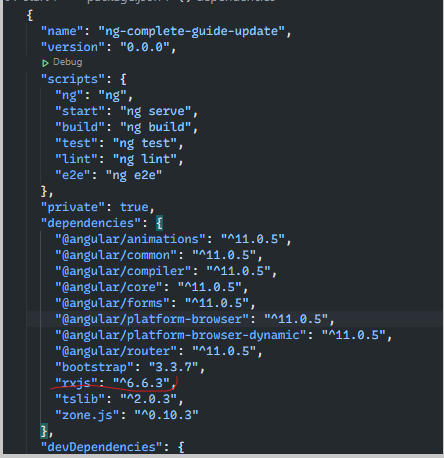Angular 学习笔记 (七) - Observables
Observable 提供了在应用程序各部分之间传递消息的支持。它们经常在Angular中使用,是一种用于事件处理、异步编程和处理多个值的技术。
观察者模式是一种软件设计模式,在这种模式中,一个对象(称为subject)维护一个称为观察者的依赖项列表,并自动通知它们状态的更改。此模式与发布/订阅设计模式相似(但不完全相同)。
Observable 是声明性的——也就是说,您定义了一个用于发布值的函数,但是在消费者订阅该函数之前不会执行该函数。订阅的消费者然后接收通知,直到函数完成,或者直到它们退订。
一个可观察对象可以交付任意类型的多个值——文字、消息或事件,这取决于上下文。接收值的API无论同步还是异步传递值都是相同的。因为设置和拆卸逻辑都是由observable处理的,所以你的应用代码只需要担心订阅和取消订阅的问题。无论流是击键、HTTP响应还是间隔计时器,监听值和停止监听的接口都是相同的。
由于这些优点,observable在Angular中被广泛使用,在应用开发中也同样如此。
Angular继承rxjs模块:

rxjs官方文档:
一. Observable
一般来说,很少自定义Observable,用其提供的Observer就可以实现功能。
一个简单的用Interval实现网页标题不断刷新时间的例子:
1 import { Component, OnInit } from '@angular/core'; 2 import { Title } from '@angular/platform-browser'; 3 import { interval } from 'rxjs'; 4 5 @Component({ 6 selector: 'app-root', 7 templateUrl: './app.component.html', 8 styleUrls: ['./app.component.css'] 9 }) 10 export class AppComponent implements OnInit{ 11 12 constructor(private titleService: Title) {} 13 14 ngOnInit() { 15 interval(1000).subscribe(val => { 16 const timestamp = new Date().toLocaleString(); 17 this.titleService.setTitle(`Hello ${timestamp}`); 18 }); 19 } 20 }
自定义Observable的例子,包含error handling和complete
- 这里一旦触发了error,observer会停止,不会触发complete
- Observable订阅了记得unsubscribe(),否则会内存泄漏
1 import { Component, OnInit, OnDestroy } from '@angular/core'; 2 import { interval, Observable, observable, Subscription} from 'rxjs'; 3 import { map, filter } from 'rxjs/operators'; 4 5 @Component({ 6 selector: 'app-home', 7 templateUrl: './home.component.html', 8 styleUrls: ['./home.component.css'] 9 }) 10 export class HomeComponent implements OnInit, OnDestroy { 11 12 private firstObsSubscription: Subscription; 13 14 constructor() { } 15 16 ngOnInit() { 17 const customIntervalObservable = new Observable(observer => { 18 let count = 0; 19 setInterval(() => { 20 observer.next(count); 21 if (count == 2){ 22 observer.complete(); 23 } 24 if (count > 3) { 25 observer.error(new Error('Count is bigger than 3')); 26 } 27 count++; 28 }, 1000); 29 }); 30 31 this.firstObsSubscription = customIntervalObservable.pipe(filter((data:number) => { 32 return (data % 2) == 0; 33 }), map((data:number) => { 34 return 'Round: ' + (data + 1); 35 })).subscribe(data => { 36 console.log(data); 37 }, error => { 38 console.log(error); 39 alert(error.message); 40 }, () => { 41 console.log('Completed'); 42 }); 43 } 44 45 ngOnDestroy() { 46 this.firstObsSubscription.unsubscribe(); 47 } 48 49 } 50
二. Operator
rxjs提供了很多Operator用于流处理的操作,上例中已经使用了map,filter
参考文档:https://www.learnrxjs.io/learn-rxjs/operators
三. Subject
Subject是一种特殊类型的Observable,它在多个观察者之间共享一条执行路径。
你可以把它想象成一个演讲者在满屋子的人面前对着麦克风说话。他们的信息(主题)正在被同时传送给许多人(多播)(观察者)。这是多播的基础。典型的观察可以与1对1的对话相媲美。
-
Subject - No initial value or replay behavior.
-
AsyncSubject - Emits latest value to observers upon completion.
-
BehaviorSubject - Requires an initial value and emits its current value (last emitted item) to new subscribers.
- ReplaySubject - Emits specified number of last emitted values (a replay) to new subscribers.
示例,Subject在service中使用,替代EventEmitter
定义Service:
1 import { Injectable, EventEmitter } from "@angular/core"; 2 import { Subject } from 'rxjs'; 3 4 @Injectable({providedIn: 'root'}) 5 export class UserService { 6 activatedEmitter = new Subject<boolean>(); 7 }
触发Subject:
onActivate() { this.userService.activatedEmitter.next(true); }
subscribe,unsubscribe :
1 import { Component, OnInit, OnDestroy } from '@angular/core'; 2 import { Subscription } from 'rxjs'; 3 import { UserService } from './user.service'; 4 5 @Component({ 6 selector: 'app-root', 7 templateUrl: './app.component.html', 8 styleUrls: ['./app.component.css'] 9 }) 10 export class AppComponent implements OnInit, OnDestroy { 11 12 userActivated = false; 13 private activatedSub: Subscription; 14 15 constructor(private userService: UserService) {} 16 17 ngOnInit() { 18 this.activatedSub = this.userService.activatedEmitter.subscribe( 19 didActive => { 20 this.userActivated = didActive; 21 } 22 ); 23 } 24 25 ngOnDestroy() { 26 this.activatedSub.unsubscribe(); 27 } 28 }


 浙公网安备 33010602011771号
浙公网安备 33010602011771号